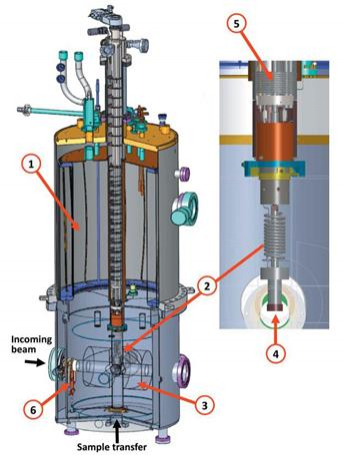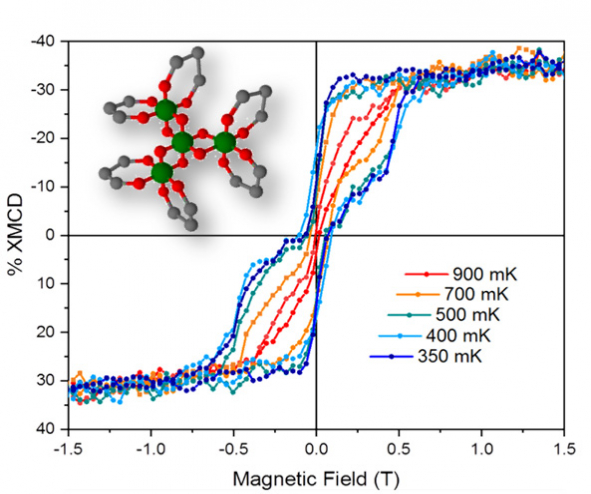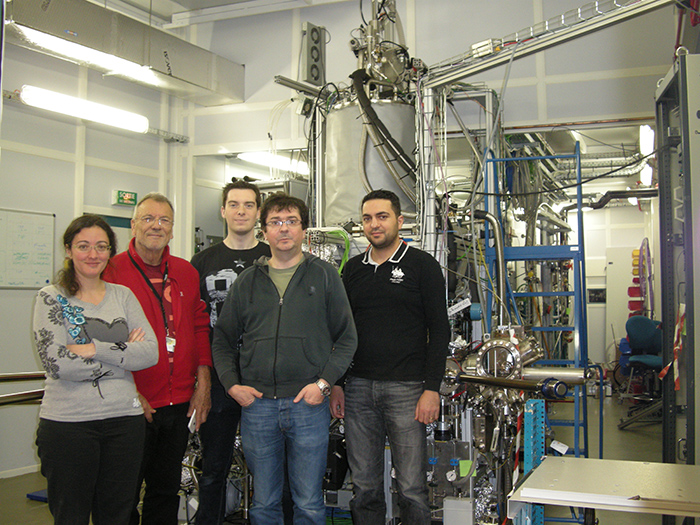Dichro50, a project supported by DEIMOS beamline and close collaborators (presented in "Rayon de SOLEIL" in January 2017) has come to an end with a world temperature record for XMCD measurements in soft x-ray domain.
Setting up a sample environment at ultralow-temperature (T << 1 Kelvin) under ultra-high vacuum for X-ray absorption measurements in a magnetic field was the major challenge of this ambitious project.
The challenge was to implant a 3He-4He dilution refrigerator (manufactured by the company CryoConcept) in the existing DEIMOS cryo-magnet, the factory tests of which achieved a limit temperature of 60 mK in ideal cryogenic conditions.
However, if you consider the experimental conditions of magnetic dichroism, namely: ultra-high vacuum, variable magnetic fields (±7 Tesla), electrical insulation of the sample and the presence of optical access (X-ray or infrared radiation), the objective of maintaining a sample exposed to a beam of X-rays at a temperature of several hundred millikelvin appears ambitious to say the least.

Figure 1: 3D drawing of DEIMOS cryostat, with (1) the main Heliq reservoir, (2) the 3He–4He dilution refrigerator, (3) 7 Tesla coils, (4) connection to the sample holder, (5) the 4 Kelwin pot used for pre-cooling and (6) retractable screens thermalized at 4 K.
The black arrows indicate the sample transfer and beam axis. The overall height is about 200 cm with a diameter of 60 cm. The diameter of the lower part of the refrigerator is 25 mm.
The first experiments, performed from March to May 2018 on the DEIMOS beamline achieved a limit temperature of 220 mK at the sample, with the latter exposed to a beam of X-rays and a 3 Tesla magnetic field.
To validate this temperature, two series of model experiments were necessary:
- One was based on the study of a bulk sample of a paramagnetic alloy (2.5% atomic Erbium in Palladium) calibrated at the Institut Néel (Grenoble) using standard magnetometry methods.
- The second series was based on measurements of the magnetisation cycles of a thin film of [Fe4 (dipivaloylmethane)6] (a.k.a. Fe4) molecules -very widely referenced by DEIMOS collaborators who are highly skilled in their synthesis and thin film preparation- demonstrating the excellent thermalization of such a sample in spite of the extreme experimental conditions.

Figure 2: top left: Molecule of Fe4, with the iron atoms in green, oxygen atoms in red, and carbon atoms in grey.
Magnetization curves measured by XMCD at the L3 edge of a Fe4 thin film, at temperatures below 1K.
This new device is a unique instrument in the world of synchrotron radiation facilities for the study of the magnetic properties of matter. Recent improvements in the field of thermal screening allowed the temperature limit to be lowered down to 175 mK, making this device an instrument without equals in the world of synchrotron radiation facilities.
Launched in 2015, Dichro50 has been supported by the programs SATT Paris-Saclay, ASTRE, PALM and Synchrotron SOLEIL on the one hand and, on the other hand, the institutes IMPMC and IPCMS as well as a consortium of ten European laboratories.
The results obtained are published in the Journal of Synchrotron Radiation News and the corresponding publicationhas the privilege to make the top cover of volume 25.

Figure 3: The team of DEIMOS beamline in front of the cryostat ; from left to right: Edwige Otero, Jean-Paul Kappler, Florian Leduc, Philippe Ohresser et Fadi Choueikani.
